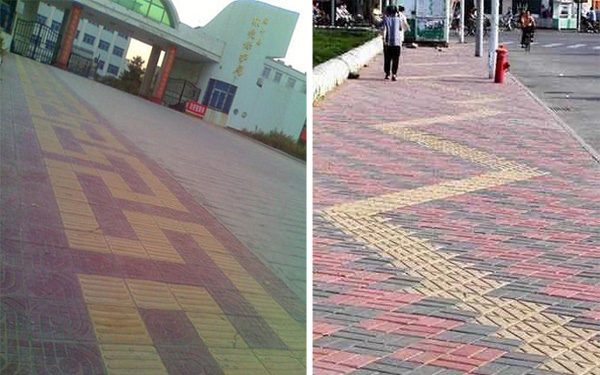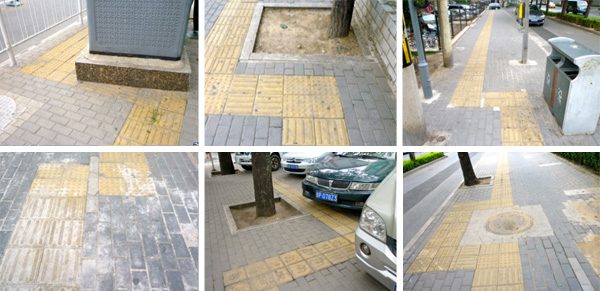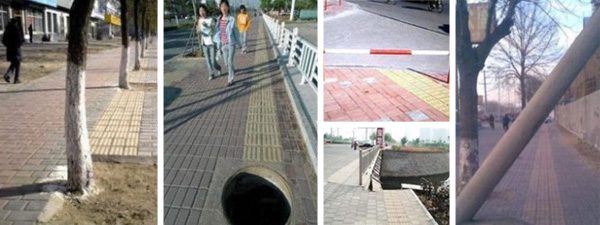Designed to help the blind and visually impaired navigate cities, tactile paving units are like braille for pavements. These raised bumps and ridges help guide people down sidewalks and across intersections. In many cases these work quite well, but in some places they have been deployed in less-successful ways (to put it mildly).

Tactile paving was first developed in Japan before spreading to other nations around the world, including Australia, Canada, the United Kingdom and the United States. Other countries, like China, have started using them more recently and with mixed results.
In most instances, raised ridges denote pathways (longer stretches between stops and changes). Raised domes, meanwhile, are used to indicate a stop or change (e.g. the presence of an intersection or edge or a shift in direction). Users register the different types of tactile signals with canes or their feet and respond accordingly. In China, however, these cues are less reliable — below are a few milder failures to start with:

When the government passed a law in 2001 requiring “blind lanes” to be built along major streets, compliance was inconsistent. The resulting implementations span a spectrum from annoying to downright dangerous. In some places, the textured tiles have simply been misused as decorative touches, defeating their critical purpose. In others, angled tile patterns force blind lanes to zig and zag their way down a street, which would surely be a bit frustrating to users.

Many of the paths are technically useful but confusing and indirect, as shown above. But in some cases tactile-paved paths represent outright hazards, steering any who would follow them into trees, holes or even off ledges. Yu Jianrong, a Chinese human rights blogger, noticed some of these more serious instances and began asking the public to submit worst-case examples, some of which are shown below:

None of this, of course, is malicious, and many of the paths work fine (while paving errors can be found in other countries as well). But when lives hang in the balance, one bad design is one too many.

Such mistakes may be a reflection of China’s (laudable) attempt to rapidly introduce accessibility features to urban environments — Beijing, for instance, speedily rolled out over 1,000 miles of tactile paths and is working to add other accessible infrastructure as well.
Still, this is a situation in which doing nothing at all is better than doing the wrong thing: potential injuries or fatalities aside, blind users need to be able to trust the systems designed for them to get them where they are going. Some cities, it would seem, still have a ways to go.



Comments (3)
Share
So happy to see one of Tom’s videos here! I haven’t seen him featured here before – are the members of 99pi well acquainted with Tom?
I was on vacation in Seoul, South Korea with my family and half my photos were of these detectable surfaces. My favorite location was on the fourth floor of a hotel in front of the elevator buttons. I also noticed that in the subway stations they have separate branches from the main path that lead to things such as ATMs and ticket machines.
In Vienna at Schwarzenbergplatz they remodeled the entrance of the McDonald’s there. It’s now a bit larger and sticks out onto the footpath next to it. But they did not adjust the tactile paving there, so it now leads right into the door of the McDonald’s. It’s been like that for at least 10 years now.